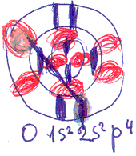Chapter 4 - Wave Theory and the Atom
Everything is formed from energetic matter by wave creation. Galaxies at certain phases create atoms.
The behaviour of our universe after the Big Bang was a swirling, inflationary movement, dispersing energy (see the chapter on the universe). The largest formations eventually break down into smaller wave-atoms. To explain the basic rules of atomic structure, I will proceed from the smallest to the largest formations. The creation of the same object occurs in different ways, so that the same type of atom may appear as an isotope.
Atoms with the highest atomic numbers are unstable and break down easily into smaller waves. The exception to the rule is hydrogen. Its atom-waves lose energy and join together. This fusion reaction results in a stable helium atom with an alpha structure. This structure plays a significant role in the formation of atoms with higher atomic numbers.
We know that atoms are composed of protons and neutrons, and that these primary structures are composed of sub-atomic formations, like those we call quarks.
In astronomical observations, we see different formations and behaviours of energetic matter. I think the best models of atomic structure are the Whirlpool Galaxy, M51 and the Stefan’s Quintet (N.G.C. 7137-20) galaxies (picture below).
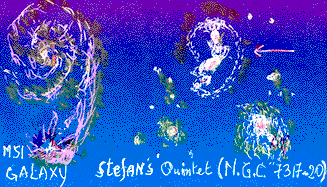
Loss of energy causes phase transitions. The main rules of energetic behaviour are the same for all phases. Photographs obtained from space show the actual behaviour of energetic matter in different stages.
Energetic wave structures have two swirls. One is an energetic Kerr swirl. The second, perpendicular to the first, is a magnetic Schwarzschild swirl, having storage properties. An energetic swirl has one direction of rotation and a magnetic swirl has another. The direction of flow in one energetic path heads in the opposite direction of the flow in the other path. In accordance with the above and with nature’s energetic principles, an atom should have the same properties we discussed earlier regarding the photon. Thus, it consists of one energetic swirl and one magnetic swirl. We may posit that a proton is like the Kerr energetic swirl, and that a neutron is like the Schwarzschild magnetic swirl, and they are connected by two energetic paths. This means that an atom consists of four formations. When it is split into two parts in an accelerator, however, each half consists of three formations (and not two): a proton or neutron swirl with half of each of the energetic paths (picture below).

In photographs of galaxies (see picture on this chapter's first page), we see condensed energetic matter (a cloud) in front of and attached to the Schwarzschild swirl. This is created by an energetic path from the Kerr swirl and may be the positron in an atom. In front of the Kerr swirl, we see a larger cloud of condensed energetic matter that, in the atom, may be an electron. It is more loosely attached to the Kerr swirl than the cloud in front of the Schwarzschild swirl.
Murray Gell-Mann introduced the name quark for what that he considered the smallest atomic particle (formation) (see the chapter on quarks). Thus, swirls and paths are quarks. (According to wave theory, energetic matter is endless and primary energetic formations come in different sizes, depending mainly on the amount of energy they have.) If we accept positron and electron clouds as formations, we can say that an atom has six quarks.
Quarks are one-ring (loop) formations; because they lack a second ring (loop), they are unstable. Every stable energy formation has a wave structure giving it a closed internal energetic circulation, which maintains energetic matter and capacity and allowing the wave to be independent and maintain its space. This is the reason that quarks can exist for only a very brief period of time.
The largest waves lose energy and disperse into space in smaller waves.
The more energetic the wave, the more readily the dispersal into smaller
waves. In some phases, atom formation occurs in one of two ways: a wave
divides into the smallest waves, which are atoms; the second way is similar
to what occurs in our sun, as high-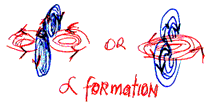 energy
atoms (waves), like hydrogen, create a more stable formation with another
similar atom by loss of energy. A helium formation appears, having a closed
wave formation of two protons and two neutrons (picture to the right).
This formation, with strong magnetic properties, is called an alpha formation
and is the most stable of its kind.
energy
atoms (waves), like hydrogen, create a more stable formation with another
similar atom by loss of energy. A helium formation appears, having a closed
wave formation of two protons and two neutrons (picture to the right).
This formation, with strong magnetic properties, is called an alpha formation
and is the most stable of its kind.
When large waves disperse, their energy transfers to the smallest waves
(atoms). Although almost every atom has the same structure, they are not
like a matrix; each has its own character. Thus, a large wave can disperse
into different isotopes, e.g., the same atoms with different energetic
levels or configurations of energetic paths. Although clones, like Dolly,
are more or less identical, in nature atoms are not.
As nature’s choice is simplicity, the basic formation of the atom is two swirls and two paths: an energetic swirl-proton, with a path to a magnetic swirl-neutron and another back to the energetic swirl. Research indicates that the structure of atoms is created by quarks, forming baryon + anti-baryon = 3 quarks + 3 anti-quarks + mesons + gluons, etc. In wave theory, which adheres to the principle that nature’s choice is simplicity, the first basic structure is an energetic wave (two photons).
Just as the swirls and paths disperse into the smallest waves ad infinitum, so energetic matter is infinite. Energetic matter flows through the two perpendicular and horizontal loops. Research shows that in protons, quarks have a two-up-one-down position (see previous page). In vertical magnetic loops (neutrons), they have an opposite, one-up-two-down position. The perpendicular loop-neutron thus flows in the opposite direction of the proton.
There are four formations in a complete wave. When atoms are split, each half has three (and not two) formations: a swirl and half of each path. The two paths connecting the proton and neutron appear as open arms, because they have been split in half. If we consider the positron and the electron energy formations, we have six formations: three quarks and three anti-quarks.
The two magnetic and energetic loops (baryons) obtained when the atom
is split rotate in different directions. The beauty of creation is that
a single electro-magnetic structure (wave) includes swirls and paths with
opposing repulsion and attraction properties (see the pictures in the
chapters on the photon and the quark). In  pictures
of the universe, we see two swirls and two paths between them, inspiring
us to understand wave formation behaviour. In very small atoms, , energetic
paths are short and very close to the swirls. Because electro-magnetic
matter does not have clear borders, excess energy can transfer to other
formations by means other than paths. Properties can pass instantly from
one loop to others via vibration. In the picture to the above-right, we
see a wave formation in the Cat’s Eye Nebula.
pictures
of the universe, we see two swirls and two paths between them, inspiring
us to understand wave formation behaviour. In very small atoms, , energetic
paths are short and very close to the swirls. Because electro-magnetic
matter does not have clear borders, excess energy can transfer to other
formations by means other than paths. Properties can pass instantly from
one loop to others via vibration. In the picture to the above-right, we
see a wave formation in the Cat’s Eye Nebula.
The structure of atoms
Living energetic matter creates atoms. They continually change shape,
because the nature of energetic matter is to be perpetually active. Just
like humans, one atom does not look alike another.
The hydrogen atom
The first atom in the element chart is hydrogen. The shape of the hydrogen
atom, photons and that of the galaxy are very similar (picture below).
A hydrogen atom is a high-energy wave expelled from a large wave, bordering
between waves and atoms, and larger than a photon. The fact that a hydrogen
atom can be in contact with large photons proves its similarity of structure.
It may be that the high-energy magnetic loop in the hydrogen atom behaves like an electron and that this is the reason that it is the vital element of organic living formations. In the hydrogen atom, the electron takes on the absent neutron’s functions, like a Schwarzschild swirl, and is highly energetic (picture below).

In this chapter, we discuss the main concepts of atom formation. See pictures of the atom from different angles (below) to better understand its structure. Using plasticine, you can create models of atoms. Although I simplify atomic structure here, the behaviour of energetic matter is very complicated, as are atom formations, which continually change. The continuous competition between the two forces, keeping its energetic formation and, simultaneously, dividing the photons’ formations and their common nets, is beyond our imagination.
The helium atom
The helium atom is composed of two similar "heavy" photons that
create a stable energy formation by the loss of a high-energy hydrogen
atom (picture below). If we add energy, we can split this formation and
get two photons again. These connected photons are a very stable formation,
known as an alpha particle. Perhaps this particle (like two photons),
obtained by Prokoshkin in his experiment, proves that structures like
photons are the basis of creation. It also proves that the last product
of matter decay is an alpha particle.

While the energetic loops swirl in one direction, merging and integrating
the photons, the magnetic rings try to separate them by moving in the
opposite direction. The energetic loops prevail, creating a four-loop
(two 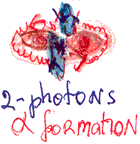 photon)
connection that is the strongest known. Every stable structure in the
universe consists of this connection. For a clearer understanding, see
the pictures below, showing the formation of the next atom in the element
chart, lithium, where the energetic loop of a new photon is connected
to the magnetic loop of the previous atom. The energetic loops of the
previous atom and the new photon are on the same plane, which is an energetic
swirl. The photon’s magnetic loop comes in contact with the previous
atom’s energetic swirl, but in a perpendicular position, so that
every new photon creates an alpha formation. This takes place not just
on one plane, as described here for purposes of simplification, but in
curved space, in accordance with the shape of a common atom swirl.
photon)
connection that is the strongest known. Every stable structure in the
universe consists of this connection. For a clearer understanding, see
the pictures below, showing the formation of the next atom in the element
chart, lithium, where the energetic loop of a new photon is connected
to the magnetic loop of the previous atom. The energetic loops of the
previous atom and the new photon are on the same plane, which is an energetic
swirl. The photon’s magnetic loop comes in contact with the previous
atom’s energetic swirl, but in a perpendicular position, so that
every new photon creates an alpha formation. This takes place not just
on one plane, as described here for purposes of simplification, but in
curved space, in accordance with the shape of a common atom swirl.
The lithium atom

A lithium atom has the basis of a helium atom. The new photon’s energetic loop is on the same plane as the energetic loops of the helium atom, but its perpendicular magnetic loop prevents it from merging with the helium atom, and instead causes the creation of a new atom .
When the energetic planes of atoms are in transverse positions, their energy integrates because the borders of energetic matter are not well defined. Their perpendicular magnetic rings maintain the integrity of each structure.
The new “photon” creates the second unclosed energetic level.
The Beryllium Atom
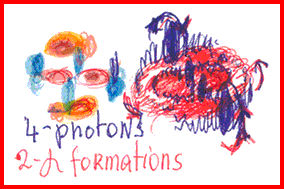 When
beryllium is formed by adding another photon, an alpha formation (a closed
second level) appears again, but with a higher energy level (pic. 8, 8a).
Note that atoms can be created in different ways or, if they are created
in the same way, they may have different characteristics.
When
beryllium is formed by adding another photon, an alpha formation (a closed
second level) appears again, but with a higher energy level (pic. 8, 8a).
Note that atoms can be created in different ways or, if they are created
in the same way, they may have different characteristics.
The Boron Atom
The boron atom opens a new layer, the third level.

The Carbon Atom

When the carbon atom appears by the addition of still another photon, an alpha formation occurs again and we close the third energy level. Up until the carbon atom, each energy level is connected by a photon and its connections
The Nitrogen Atom
If a photon is added to a carbon atom, one loop of the photon will be
connected to the third energy level, and its second loop will create an
additional energy level, which I call three+ (picture, below left). This
level contains only one loop, or half the photon. In this formation, we
have four residual covalences that can accept four more photons. The energy
level of the connections will be higher than the third level. To better
under-stand these simple and, at the same time, complex formations, use
plasticine models, as shown in the illustra-tions in this chapter.
The Oxygen Atom
|
|
The Fluorine Atom
|
The Neon Atom
In this atom, the photons close the third level and cannot be added to
additional high-energy photons (pictures to follow).

I use simple structures here as illustrations. The connections are more
complex, however, as atoms with more than one neutron per proton create
different isotopes. Wave theory helps explain atom formation. The sequence
is as follows: first, a Kerr swirl appears. The Kerr swirl creates a singularity
that, in turn, sends paths (strings). The paths generate Schwarzschild
formations. The latter generate paths with an electron cloud connecting
back to the Kerr swirl and completing a closed formation.
The Kerr swirls create Schwarzschild swirls in proportion to the energy
available when the main Kerr swirl was created. Gradually, the Kerr swirl
melts more energetic matter than the Schwarzschild swirl can handle, and
the excess energy forms another Schwarzschild swirl. These additional
swirls have the same role in the circulation and conservation of energy
as the first. In atoms that are isotopes, the amount of neutrons is the
result of the dispersion of waves with more than one Schwarzschild swirl,
or of smaller waves with more than one magnetic swirl. Pictures taken
in space illustrate this beautifully.
The atom is a concentration of energetic matter in time and space in lower phases. It creates complex relationships with its neighbours. Schwarzschild swirls play a role in the conservation of energy in waves. In a wave’s natural life cycle, however, energetic matter continually undergoes changes in time and space, causing energy levels to decrease, ending in dispersion. Nearby formations undergoing the same process are similar, but not identical. We can see this process most clearly by looking at the half-life of atoms. Energy returns to space to create a new life cycle. Energy is space and space is energy.
Now I would like to discuss the forces in the atom and in nature after the Big Bang. In nature, we have primal energetic matter with a single behaviour: a swirling, inflationary motion (see the chapter on the universe).
Energetic matter creates waves, with two swirls and two paths. Energetic matter, even in swirls, moves by paths (strings). Different directions of motion create different forces.
The two main swirls of a wave create the major forces of the universe. The strong pushing and weak pulling force of the Kerr swirl counters the strong pulling and weak pushing force of the Schwarzschild swirl. These opposing forces generate all known forces.
1. Energetic force = primal energetic matter. When a wave is created,
secondary magnetic forces appear.
2. Strong force = generated by energetic loop activity and acting at a
distance determined by the transverse loop
3. Weak force = generated by magnetic loop activity; acting even further
than energetic matter.
Gravitational force is a complex of all forces and relationships between
energetic paths and formations (waves) (see the chapter on the universe).
When atoms are split in accelerators, we obtain a large amount of different particles (energetic forces), a “zoo” of particles. Because energetic matter creates endless forces (paths, energy levels), its formation possibilities are infinite.
- end -
Back to Top
Dr. Chaim Tejman, Copyright© 2001. All rights reserved.




